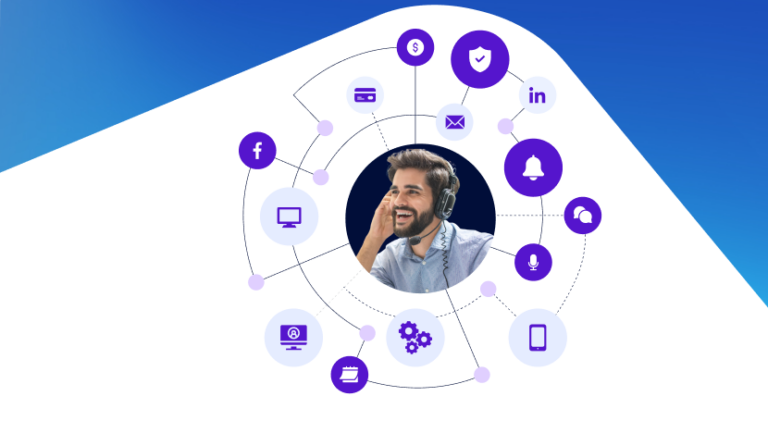E-commerce app success in APAC hinges on seamless customer experiences. Discover how the region’s ecommerce giants are leading the way using communication APIs and SDKs in their platforms.
We live in an information age where facts and falsehoods alike can spread quickly through the population like a… wait for it… virus.
It’s therefore critical for governments to ensure that the public is updated with relevant information as soon as possible.
Traditional media is no longer sufficient by itself.
More governments are digitalising their information and communication systems, enabling them to reach out to their citizens across multiple channels such as social media, SMS and email.
That said, there is still a long way to go.
Here are some harsh (but truthful) facts:
“80% of government officials believed that their organization hasn’t done much in terms of digital advancements.”
– Seven pivots for government’s digital transformation, Deloitte
There are multiple areas where governments need to work to accelerate digital transformation.
One of these is effective communication. Mostly, the transition to a better communication system is not that smooth. This is because the legacy systems that the various ministries or agencies use make it extremely difficult for them to move to a modern or a cloud-based system.
Therefore, tools that enable internal access to the same information are needed to make this shift easy.
This would remove the friction for the government to adopt new changes.
In addition, transitioning systems to the cloud would enable a major portion of the public service workforce to work from home with secure communication channels like chat or voice-based contact centres.
These efforts not only reduce the workload of the employees but also provide a great user experience to the citizens. All this, while working from home.
And, a major reason that is pushing governments to accelerate the digital transformation is customer expectation. They expect the same service from government agencies as they do from the private sector. This makes it even more important for the government to speed up this transformation.
An example is the wide variety of digital tax payment and filing systems that have been adopted by Singapore, Indonesia, Malaysia, etc. that has improved compliance rates.
Rethinking work, adopting changes and moving digital
Digital transformation in the public sector has rapidly grown into a mature, stable and well-established system.
This was not the case a year back when online portals of governments were not very active. This was mainly because the websites would hang, there would be no provisions for online payments or people simply didn’t trust the online system.
But, given the current circumstances, this is the only system people can rely on now.
As a result of the pandemic, we have witnessed years of digital transformation packed into a matter of months.
With such a fast rate of acceleration, we can expect that the journey would be full of bumps and hurdles.
Here’s how governments can smoothen the transition:
Digital transformation for government: Challenges, improvements and the path ahead
1. Digital growth and online interaction
Countries should work on a framework that incorporates a national digital agenda. There should be policies, strategies, and legislation that can identify the goals and objectives for digital success.
A proper plan should be created to decide the steps to reach this digital transformation.
The three basic areas to focus on while engaging in this plan will be operations, delivery of the services & engagement of the stakeholders.
This can provide a good citizen-centred digital transformation.
So, the next time, citizens don’t need to worry about the loading time of governments and they can easily apply for a voters card (or conduct any other process).
2. Cybersecurity and the aftermath of hacking
To have a secure system is the most crucial factor for a government and this should be given more priority than anything else.
Cybersecurity and cyberattacks are crucial topics that need immediate attention by any government.
Every country should have a plan that considers all cyberattacks to protect the integrity of the national infrastructure.
Internet Protocol (IP), IoT systems and analytics can be leveraged to detect cyber threats and also respond to them.
3. Innovation and advanced technology
Governments usually operate with legacy IT systems, which tend to be rigid, complex and costly to replace. This ultimately impacts the shift to a better system.
The good thing is, not all legacy systems have to be replaced. There are many ways to manage this transition. One way is to engage hybrid vendors to handle it without disrupting the current systems.
4. Inter-agency coordination
Digital transformation needs a lot of coordination between different parts of the public service to ensure secure and seamless data transfer and processes are reflected in the final system.
Online portals are simply a representation of different government ministries and agencies on the internet.
So, the system will be as simple as the knowledge and understanding of people building it. This is the reason that government ministries and agencies need a proper plan that reflects their vision and goals. This plan can finally be shifted to a digital version easily.
5. Integrations for a better user experience
Ensuring that the systems used by all agencies are interconnected would eliminate data siloes and truly enable digital citizenship. With data aligned across all ministries, public service agents would be able to access accurate and relevant information to help and communicate with citizens.
What does an action plan for government digitalisation look like?
1. Flexible infrastructure – more agility and speed
It is extremely important for governments to work on a flexible infrastructure that provides faster access to the citizens. This is only possible when they have a simple and agile system.
For example, Rhode Island (a state of New England in the US) completely transformed its contact centre for the insurance of the unemployed population.
They could see the calls moving from 75 straight up to 2000. And they were able to handle this transition within 10 days of adopting cloud solutions.
“This project proved we can be more agile and get fast, high-value results for our state and our constituents. It’s time to innovate and see how we can make the user experience better when people need us.”
– Scott Jensen, Director of the Department of Labor and Training
2. Faster communication, higher satisfaction
SMSes are extremely important to build trust with the population.
SMS is the most available communication channel that can be easily leveraged to create a great user experience.
It’s very simple to set up and doesn’t need a rigid system.
Singapore’s Public Utilities Board (PUB) for example, uses SMS services to constantly engage their customers with account updates and notifications of upcoming storms and expected flood areas to avoid.
This reduces anxiety and satisfies customers that their needs are being heard and will be responded to.
3. 2FA – building more authentic systems
Two-factor authentication is not an option but a mandatory requirement to go completely digital.
It assures users of their data security and they can easily update their information online without worrying about the aftermath.
With a strong system in place, user confidence will increase.
4. IVR – connecting people, connecting lives
Post-COVID life has become more about virtual interactions. Good or bad, having a permanent, stationary workstation is a thing of the past.
This means that communication systems have to be flexible enough to accommodate changing working arrangements.
With cloud communications, you can easily let employees make or receive calls at their suitable hours, route calls using IVR and create workflows to automate communications.
It also keeps information on all interactions centralized, accessible and unified.
Let’s take a look at an example of e-governance in Malaysia:
Under a program introduced by the former Prime Minister of Malaysia, more e-governance initiatives were introduced to improve connections between government agencies, citizens and businesses through electronic services, procurement and project management platforms.
One initiative was the introduction of interactive voice response (IVR) systems to help citizens access the support they need. This is managed through a call centre, and has become a crucial part of the Malaysian e-governance system.
5. Automation – simpler processes
How easy or difficult is it to get yourself registered for a government scheme currently?
In many traditional systems, you would visit the online portal, upload your ID, get yourself signed up, enter 100 different details until the portal logs you out and says, “Your session has expired”.
Sounds familiar?
Well, here’s an example of using automation to eliminate the need for citizens to perform any of these steps.
Austria has a super-intelligent system that adds a child to the family allowance program as soon as they are born. This is simple, and unifies different hospitals, tax office and other government bodies involved.
This completely takes the burden away from the main workforce so they can focus on more urgent tasks.
6. Integration of different cloud systems
Private sectors have been quick to integrate different tools to provide the best customer experience.
So, it’s high time that the government also does the same. This would speed up their internal processes and cut a lot of red tape. In case of increased demand, we need a system that works with speed and efficiency while minimising human errors.
Integrating employee and citizen communication channels with controlled access to the government system would be a good place to start.
Here is what a successful digital plan would look like this:
- Residents can access the online portal 24/7.
- Different and diverse groups can get together to think of better ways to speed up the digitization process.
- Every single person using the services feels that it’s safe to share sensitive information, giving a more secure experience.
- In case of any urgent requirement, every single resident (regardless of location) can access and use the services.
- Users trust the platform and are willing to conduct financial transactions online.
- There is a defined process that also sends confirmation and SMS updates to users when services are being used.
There can literally be 100 more points here, but this plan is going to change according to your current needs and future goals.
 Nora Huin
Nora Huin 


 V K Sanjeed
V K Sanjeed 
 Celine Ke
Celine Ke 
 John Tolton
John Tolton